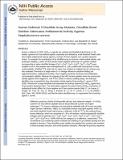| dc.contributor.author | Wanniarachchi, Yoshitha A. | |
| dc.contributor.author | Kaczmarek, Piotr | |
| dc.contributor.author | Wan, Andrea | |
| dc.contributor.author | Nolan, Elizabeth M. | |
| dc.date.accessioned | 2013-11-25T17:39:19Z | |
| dc.date.available | 2013-11-25T17:39:19Z | |
| dc.date.issued | 2011-09 | |
| dc.date.submitted | 2011-08 | |
| dc.identifier.issn | 0006-2960 | |
| dc.identifier.issn | 1520-4995 | |
| dc.identifier.uri | http://hdl.handle.net/1721.1/82575 | |
| dc.description.abstract | Human α-defensin 5 (HD5, HD5[subscript ox] to specify the oxidized and disulfide linked form) is a 32-residue cysteine-rich host-defense peptide, expressed and released by small intestinal Paneth cells, that exhibits antibacterial activity against a number of Gram-negative and -positive bacterial strains. To ascertain the contributions of its disulfide array to structure, antimicrobial activity, and proteolytic stability, a series of HD5 double mutant peptides where pairs of cysteine residues corresponding to native disulfide linkages (Cys[superscript 3]-Cys[superscript 31], Cys[superscript 5]-Cys[superscript 20], Cys[superscript 10]-Cys[superscript 30]) were mutated to Ser or Ala residues, overexpressed in E. coli, purified, and characterized. A hexa mutant peptide, HD5[Ser[superscript hexa]], where all six native Cys residues are replaced by Ser residues, was also evaluated. Removal of a single native S–S linkage influences oxidative folding and regioisomerization, antibacterial activity, Gram-negative bacterial membrane permeabilization, and proteolytic stability. Whereas the majority of the HD5 mutant peptides show low micromolar activity against Gram-negative E. coli ATCC 25922 in colony counting assays, the wild-type disulfide array is essential for low micromolar activity against Gram-positive S. aureus ATCC 25923. Removal of a single disulfide bond attenuates the activity observed for HD5[subscript ox] against this Gram-positive bacterial strain. This observation supports the notion that the HD5[subscript ox] mechanism of antibacterial action differs for Gram-negative and Gram-positive species [Wei et al. (2009) J. Biol. Chem.284, 29180−29192] and that the native disulfide array is a requirement for its activity against S. aureus. | en_US |
| dc.description.sponsorship | Massachusetts Institute of Technology. Biophysical Instrumentation Facility ((NSF- 0070319) | en_US |
| dc.description.sponsorship | Massachusetts Institute of Technology. Biophysical Instrumentation Facility (NIH GM68762) | en_US |
| dc.language.iso | en_US | |
| dc.publisher | American Chemical Society | en_US |
| dc.relation.isversionof | http://dx.doi.org/10.1021/bi201043j | en_US |
| dc.rights | Article is made available in accordance with the publisher's policy and may be subject to US copyright law. Please refer to the publisher's site for terms of use. | en_US |
| dc.source | PMC | en_US |
| dc.title | Human Defensin 5 Disulfide Array Mutants: Disulfide Bond Deletion Attenuates Antibacterial Activity against Staphylococcus aureus | en_US |
| dc.type | Article | en_US |
| dc.identifier.citation | Wanniarachchi, Yoshitha A., Piotr Kaczmarek, Andrea Wan, and Elizabeth M. Nolan. “Human Defensin 5 Disulfide Array Mutants: Disulfide Bond Deletion Attenuates Antibacterial Activity against Staphylococcus aureus.” Biochemistry 50, no. 37 (September 20, 2011): 8005-8017. | en_US |
| dc.contributor.department | Massachusetts Institute of Technology. Department of Chemistry | en_US |
| dc.contributor.mitauthor | Wanniarachchi, Yoshitha A. | en_US |
| dc.contributor.mitauthor | Kaczmarek, Piotr | en_US |
| dc.contributor.mitauthor | Wan, Andrea | en_US |
| dc.contributor.mitauthor | Nolan, Elizabeth M. | en_US |
| dc.relation.journal | Biochemistry | en_US |
| dc.eprint.version | Author's final manuscript | en_US |
| dc.type.uri | http://purl.org/eprint/type/JournalArticle | en_US |
| eprint.status | http://purl.org/eprint/status/PeerReviewed | en_US |
| dspace.orderedauthors | Wanniarachchi, Yoshitha A.; Kaczmarek, Piotr; Wan, Andrea; Nolan, Elizabeth M. | en_US |
| dc.identifier.orcid | https://orcid.org/0000-0002-6153-8803 | |
| mit.license | PUBLISHER_POLICY | en_US |
| mit.metadata.status | Complete | |
